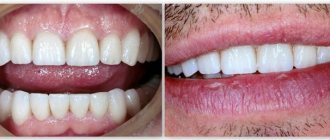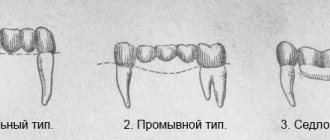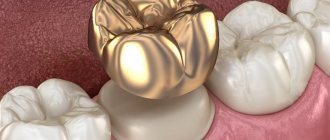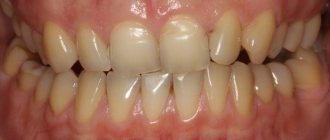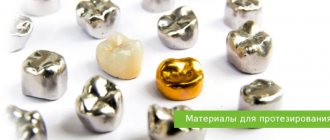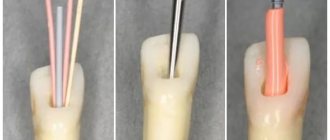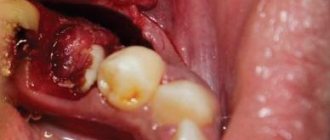Today, one of the most popular methods of correcting teeth and restoring tooth enamel is installing veneers. Veneers are thin plates that are placed on the front of the tooth. This method can make a smile graceful, hiding existing imperfections. The most important preparatory stage in installing veneers is the choice of material from which the structure will be made.
Materials for making veneers
Ceramics. Among the advantages of ceramic veneers, it is worth highlighting their high strength, which can be compared with the strength of a real tooth. Porcelain veneers are made in a dental laboratory from a previously taken impression. Ceramic veneers have a natural appearance that can be absolutely identical to other teeth. Also, the most important advantage of such veneers is their long service life. Ceramic veneers are resistant to food dyes and retain their color and shine for a long time. The disadvantages of ceramic veneers include the need to file away an impressive layer of hard tissue, which can result in weakened teeth.
Composite material. Along with ceramic, composite veneers are a very popular option for correcting tooth shape. However, veneers made from composite materials do not require cutting down tooth enamel, which is a huge advantage. One of the varieties of composite veneers are direct veneers, the distinctive feature of which is the construction of the structure directly in the patient’s mouth. The disadvantages of composite veneers include the possibility of aesthetic defects and partial loss of color and shine after several years. However, the cost of veneers made from composite materials is the most affordable.
Lumineers. This type of veneers is particularly thin. The advantages of lumineers are the preservation of tooth enamel without negative effects on it, as well as the ability to remove the structure at any time. Due to their quality characteristics, lumineers are also called “Hollywood” veneers.
General overview
From a technical point of view, veneering is a procedure in which thin ceramic onlays are attached to the surface of the front elements of the dentition, covering the entire crown. They improve the appearance of incisors and canines, protect them from mechanical damage, and form an attractive “Hollywood” smile. Plates fixed to the enamel using an adhesive composition belong to the category of microprostheses, mask defects, and prevent the development of a number of dental diseases.
Methods for making veneers
Application in layers. This method involves carefully pressing platinum foil onto the prepared tooth and layer-by-layer application of the ceramic composition. To avoid the risk of shrinkage and distortion, the foil fixes the finished solution by firing. The layer-by-layer application method is the least expensive.
Casting method. This method involves making a wax overlay on a plaster model and covering it with a special glass-ceramic composition. The structure is placed in a refractory mass, the wax is melted and burned out, after which the mass is removed. The final stage of the casting method is painting the veneers in a color identical to the patient’s tooth enamel and grinding. The great advantage of the casting method is the possibility of obtaining an aesthetic effect and structural strength.
Computer modeling method (using CAD/CAM technologies). This method of making veneers involves obtaining a digital model of the ground and adjacent teeth using a 3D scanner. Modeling of microprostheses is performed in a special computer program, after which technicians produce the design itself within 3-5 minutes. Next, the veneers are sanded and glazed, after which the product is considered ready. Computer modeling is considered one of the fastest methods for making veneers.
Indications for installation of veneers:
- Presence of visible gaps between teeth.
- Violation of the integrity of the enamel.
- Curvature of the dentition.
- Eliminate crowding of teeth.
- Loss of color and shine after removal of the dental nerve.
- Elimination of chips on enamel.
- Removing the yellow color of tooth enamel if whitening does not help.
Contraindications for installing veneers:
- A small number of teeth in a row or their absence.
- Curvature of the dentition.
- Presence of dental caries.
- Periodontitis.
- Bridges.
- Weak tooth enamel.
- Teeth grinding (bruxism).
- Pathological abrasion of teeth.
Own dental laboratory
The dental laboratory is the production basis of the orthopedic dentistry department.
And your own dental laboratory is a good reason to brag. This is one of the advantages of the SmileStudio clinic, which we are very proud of. Our laboratory employs the best technicians who do their work efficiently and quickly. Our own dental laboratory makes it possible to minimize the time required to manufacture veneers. Thanks to this, the entire manufacturing process goes very quickly, and the patient becomes the owner of a snow-white smile in the shortest possible time - in just 3-7 days!
The SmileStudio dental laboratory also produces other orthopedic structures (prostheses, crowns, etc.) that meet all the aesthetic and functional requirements of dentistry.
Effective communication between the dentist and dental technician is a key aspect of planning and executing the preparation of severely discolored dental tissues. A well-coordinated team approach allows us to get the job done as quickly and efficiently as possible. In such cases, the creation of functional and aesthetic restorations leads not only to a change in the patient’s smile, but also to a significant increase in his self-esteem. To achieve this goal, the dentist and dental technician must use optimal techniques and high-quality materials, and also have a clear understanding of the final result of the treatment before starting tooth preparation.
Production of direct veneers and their installation
Ceramic and composite veneers differ significantly in thickness. At the same time, its color directly depends on the thickness of the plate. The lighter the enamel, the thicker the veneers. The degree of tooth preparation is selected based on the shade of the enamel and the type of damage. The structure is installed in one day. After installation, the finished product is sanded and turned.
Stages of manufacturing and installation of veneers:
- Consultation. This is the first and very important stage of installing veneers. During the consultation, the doctor will be able to conduct an examination, make some notes for himself, and the patient will talk about his wishes.
- Cleaning tooth enamel. This stage should not be neglected, as this may result in discoloration along the edges of the veneers and the formation of plaque. The procedure is carried out using special safe solutions.
- Tooth turning. Depending on the thickness of the veneer, a certain layer of hard tissue is removed.
- Taking an impression. To make an impression, a tray with molding mass is pressed against the teeth until it hardens completely.
- Installation of temporary plates to protect against external influences.
- Making a plaster cast.
- Manufacturing of the product.
- Trying on the design, fitting, and, if necessary, correction.
- Fixation of microprosthesis. After preliminary washing and drying of the pad, the doctor fixes the product with special cement.
- The choice of shade of a microprosthesis is one of the important points. The enamel color is selected in daylight, while the onlay and tooth must be wet to reveal the natural shade of the enamel.
Installation of ceramic veneers
The manufacture and installation of veneers requires careful and careful work of the technician and doctor involved in the work. Thanks to modern technologies, it is possible to install veneers not only on individual teeth, but also on entire rows of teeth.
When making ceramic veneers, 3 components are involved - the tooth itself, a ceramic microprosthesis and a fixing material. In order to create the necessary adhesion strength, the veneers are etched with an acid solution. Tooth enamel is cleaned of cement mortar and etched, creating a microrelief, then washed and dried. The adhesive is applied to the surface of the tooth, after which the veneer adheres to the tooth enamel.
In what cases should you install
Attention! Typically, veneers are installed only at the request of the patient; there is no need to have indications for this. As a rule, these products are used to improve the shape and color of teeth, and also if the patient dreams of having a Hollywood smile. But still, there are some indications for which veneers are installed:
- ugly and uneven shape of teeth;
- the presence of a pronounced yellow tint of the front incisors;
- change in shade after depulpation;
- the presence of an enamel erosion process, for example, after a tooth has chipped due to any reason;
- wide spaces between teeth with an unsightly shape, as well as rotated, crowded incisors;
- can be used when other recovery methods have not provided the desired results.
Composite veneers are a method of aesthetic correction of a patient’s smile, which is used for cracks and chips in teeth, discoloration, curvature of teeth, and large interdental spaces.
Veneer care
- The great advantage of veneers is that they do not require special care, so immediately after installation of the structure, the patient can lead his usual lifestyle. However, to extend the life of microprostheses, it is still necessary to perform a number of measures:
- Limit yourself in consuming foods that can have a negative effect on veneers (nuts, hard toffee, seeds).
- Take regular care of your oral cavity. Dental floss, which is familiar to everyone, copes well with this role. Rinse aid won't hurt either.
- Use an irrigator to thoroughly treat the gums and gingival areas.
- Choose a toothpaste that does not contain large particles of cleaning elements.
- Minimize the consumption of coloring products.
- Visit the dentist.
Service life of veneers
Depending on the manufacturing method, the service life of the finished product may vary. Thus, direct veneers can last up to 7 years, but after 2-3 years the aesthetic properties of such microprostheses deteriorate.
Ceramic veneers can last up to 20 years if properly cared for. It must be remembered that the service life of the product may be reduced if the structure is improperly manufactured and fixed. Therefore, it is worth contacting competent specialists. It should also be noted that you cannot “over-wear” the veneers, since after the expiration of their service life there is a risk of the plate falling out.
Veneers are a high-tech development with which you can quickly and easily get a perfect smile. The technology for manufacturing microprostheses is being improved from year to year, which makes it possible to reduce the degree of filing of the tooth surface, while obtaining excellent results.
Expert opinion
Evgenia Vladimirovna Bolshakova
hygienist
Experience: 10 years
Some patients are afraid to get veneers because of the need to grind down the enamel and are looking for options without the need to prepare the top layer. But this point is extremely important, as it allows for maximum adhesion and tightness of the lining. In this case, plaque does not get clogged underneath it and the risk of developing caries in the tooth restored with the onlay is reduced. If for some reason the veneers have to be removed, the prepared front part will require prosthetic crowns.
